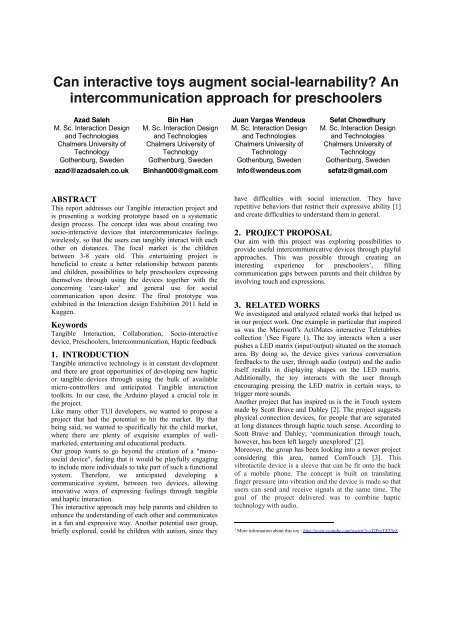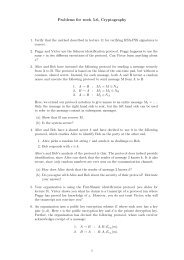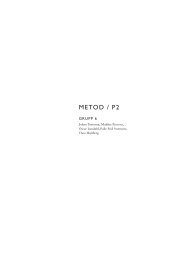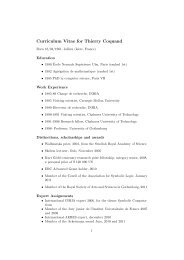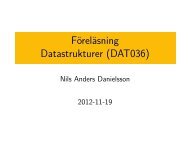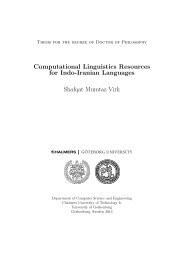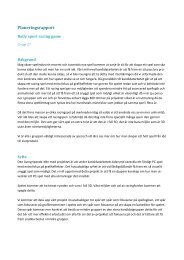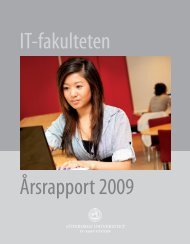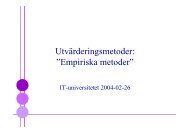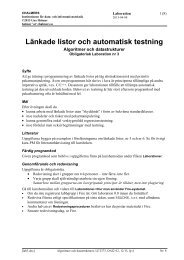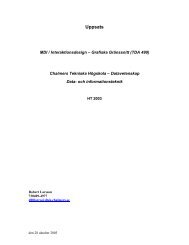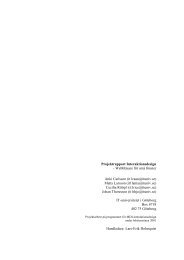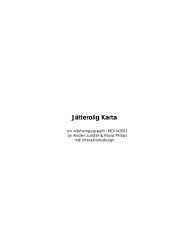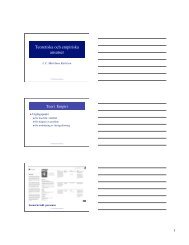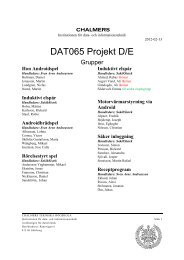Can interactive toys augment social-learnability? An ...
Can interactive toys augment social-learnability? An ...
Can interactive toys augment social-learnability? An ...
You also want an ePaper? Increase the reach of your titles
YUMPU automatically turns print PDFs into web optimized ePapers that Google loves.
<strong>Can</strong> <strong>interactive</strong> <strong>toys</strong> <strong>augment</strong> <strong>social</strong>-<strong>learnability</strong>? <strong>An</strong><br />
intercommunication approach for preschoolers<br />
Azad Saleh<br />
M. Sc. Interaction Design<br />
and Technologies<br />
Chalmers University of<br />
Technology<br />
Gothenburg, Sweden<br />
azad@azadsaleh.co.uk<br />
Bin Han<br />
M. Sc. Interaction Design<br />
and Technologies<br />
Chalmers University of<br />
Technology<br />
Gothenburg, Sweden<br />
Binhan000@gmail.com<br />
ABSTRACT<br />
This report addresses our Tangible interaction project and<br />
is presenting a working prototype based on a systematic<br />
design process. The concept idea was about creating two<br />
socio-<strong>interactive</strong> devices that intercommunicates feelings<br />
wirelessly, so that the users can tangibly interact with each<br />
other on distances. The focal market is the children<br />
between 3-8 years old. This entertaining project is<br />
beneficial to create a better relationship between parents<br />
and children, possibilities to help preschoolers expressing<br />
themselves through using the devices together with the<br />
concerning ‘care-taker’ and general use for <strong>social</strong><br />
communication upon desire. The final prototype was<br />
exhibited in the Interaction design Exhibition 2011 held in<br />
Kuggen.<br />
Keywords<br />
Tangible Interaction, Collaboration, Socio-<strong>interactive</strong><br />
device, Preschoolers, Intercommunication, Haptic feedback<br />
1. INTRODUCTION<br />
Tangible <strong>interactive</strong> technology is in constant development<br />
and there are great opportunities of developing new haptic<br />
or tangible devices through using the bulk of available<br />
micro-controllers and anticipated Tangible interaction<br />
toolkits. In our case, the Arduino played a crucial role in<br />
the project.<br />
Like many other TUI developers, we wanted to propose a<br />
project that had the potential to hit the market. By that<br />
being said, we wanted to specifically hit the child market,<br />
where there are plenty of exquisite examples of wellmarketed,<br />
entertaining and educational products.<br />
Our group wants to go beyond the creation of a "mono<strong>social</strong><br />
device", feeling that it would be playfully engaging<br />
to include more individuals to take part of such a functional<br />
system. Therefore, we anticipated developing a<br />
communicative system, between two devices, allowing<br />
innovative ways of expressing feelings through tangible<br />
and haptic interaction.<br />
This <strong>interactive</strong> approach may help parents and children to<br />
enhance the understanding of each other and communicates<br />
in a fun and expressive way. <strong>An</strong>other potential user group,<br />
briefly explored, could be children with autism, since they<br />
Juan Vargas Wendeus<br />
M. Sc. Interaction Design<br />
and Technologies<br />
Chalmers University of<br />
Technology<br />
Gothenburg, Sweden<br />
info@wendeus.com<br />
Sefat Chowdhury<br />
M. Sc. Interaction Design<br />
and Technologies<br />
Chalmers University of<br />
Technology<br />
Gothenburg, Sweden<br />
sefatz@gmail.com<br />
have difficulties with <strong>social</strong> interaction. They have<br />
repetitive behaviors that restrict their expressive ability [1]<br />
and create difficulties to understand them in general.<br />
2. PROJECT PROPOSAL<br />
Our aim with this project was exploring possibilities to<br />
provide useful intercommunicative devices through playful<br />
approaches. This was possible through creating an<br />
interesting experience for preschoolers’, filling<br />
communication gaps between parents and their children by<br />
involving touch and expressions.<br />
3. RELATED WORKS<br />
We investigated and analyzed related works that helped us<br />
in our project work. One example in particular that inspired<br />
us was the Microsoft's ActiMates <strong>interactive</strong> Teletubbies<br />
collection 1 (See Figure 1). The toy interacts when a user<br />
pushes a LED matrix (input/output) situated on the stomach<br />
area. By doing so, the device gives various conversation<br />
feedbacks to the user, through audio (output) and the audio<br />
itself results in displaying shapes on the LED matrix.<br />
Additionally, the toy interacts with the user through<br />
encouraging pressing the LED matrix in certain ways, to<br />
trigger more sounds.<br />
<strong>An</strong>other project that has inspired us is the in Touch system<br />
made by Scott Brave and Dahley [2]. The project suggests<br />
physical connection devices, for people that are separated<br />
at long distances through haptic touch sense. According to<br />
Scott Brave and Dahley; ‘communication through touch,<br />
however, has been left largely unexplored’ [2].<br />
Moreover, the group has been looking into a newer project<br />
considering this area, named ComTouch [3]. This<br />
vibrotactile device is a sleeve that can be fit onto the back<br />
of a mobile phone. The concept is built on translating<br />
finger pressure into vibration and the device is made so that<br />
users can send and receive signals at the same time. The<br />
goal of the project delivered was to combine haptic<br />
technology with audio.<br />
1 More information about this toy : http://www.youtube.com/watch?v=TjPtgTXT5e8
Finally, we looked into the LumiTouch [4], which was all<br />
about communicating through pair of <strong>interactive</strong> photo<br />
frames. The photo frame lights up when a user touches the<br />
photo frame and is translated over an internet connection<br />
[4]. Each colour lighten up by the user, symbolizes a<br />
certain feeling that can create a colour combination,<br />
conveying a certain meaning.<br />
3.1 The Concept<br />
The overall concept was challenging and we had to design<br />
it under three weeks time, fully functional. We<br />
brainstormed and made a task list before going into further<br />
depth with the Concept.<br />
3.1.1 Idea behind the concept<br />
The goal with the concept was to create two socio<strong>interactive</strong><br />
devices 2 that communicates feelings wirelessly,<br />
so that users can interact with each other on distances (See<br />
Figure 2), i.e. being in different places. We will give three<br />
example scenarios were such a communication device<br />
might be used:<br />
• In a fun and efficient way to create a better relationship<br />
and understanding between parents and children.<br />
• To help children with autism to express their feelings<br />
towards their ‘care-takers’ as well as letting them<br />
understand the needs of the concerned child.<br />
• General emotional communication scenarios upon desire<br />
for <strong>social</strong> and entertainment purposes.<br />
3.1.2 Initial concept sketches<br />
We followed a typical “form follows function” dogma<br />
(Cooper 2007), hence sketched a template for the skeleton<br />
of the system for both devices, to keep the design<br />
proportional. We also tried to sketch the expected visual<br />
feedback (feelings) given from the devices and the aesthetic<br />
appeal of the device.<br />
Figure 1 - Microsoft's ActiMates <strong>interactive</strong> Teletubbies collection<br />
2 Description and BellyBuddies in action here:<br />
http://www.youtube.com/watch?v=I4iLxePMVig<br />
Figure 2 - Example interaction process to activate the toy in order to<br />
establish communication<br />
3.2 Realizing the Project<br />
We used one Arduino board connected to the two <strong>toys</strong> through<br />
wires, to visualize emotions such as happiness or sadness, through<br />
using an output LED-matrix and a pressing area functioning by<br />
using flex sensors. These flex sensors measure the pressure of the<br />
fingers and so outputting movement from the servo motors and<br />
additionally triggers the visual feedback. For example, if ‘Device<br />
A’ is pushed with intense force (flex sensor), ‘Device B’ will<br />
result in crouching and will display a sad mouth (the visual<br />
feedback).<br />
3.2.1. Electronics and mechanisms<br />
Although this prototype was using wires from the Arduino to<br />
connect the components of the two <strong>toys</strong>, the idea is to do a<br />
wireless toy as a final product.<br />
Furthermore, we wanted to make a turn based system, which<br />
provides visual feedback that consists of a LED soldered with<br />
wires, put inside the designed antenna for each toy, giving better<br />
interaction feedback between users.<br />
The antennas were made and arranged spatially by using the<br />
previously mentioned blueprint or skeleton, that was sketched on<br />
RHINO 3D.<br />
The servomotors control the crouching movement, by rotating at<br />
opposite directions and were thoroughly reflected upon before<br />
construction. The design goal of it was to set a balanced and<br />
consistent movement, which after a lot of struggle, we succeeded<br />
to achieve. Each servomotor was carefully attached with glue,<br />
tape, metal pieces and screws and so added firmly to the material.<br />
Like previously discussed, we wanted to add a LED matrix for<br />
visual feedback. The idea is that when the toy is happy, it should<br />
display a ‘happy smile’ through illuminating LEDs in a specific<br />
color of choice (See Figure 3).<br />
3.2.2 Programming<br />
Using the Arduino programming language, we achieved a<br />
communication structure, which allows users to control the <strong>toys</strong>.<br />
Although some programming issues with the turn based system<br />
due to the flex sensors being too sensible when applying a small<br />
movement, another majorly concerning issue was the<br />
programming of the RGB LED matrix. By this being said,<br />
creating our own custom built LED circuit board to simulate the<br />
similar effect as the RGB LED matrix, allowed us to simply<br />
switch the LEDs On or Off.<br />
3.2.3 Outer Shell Design<br />
Initially, we had to plan out what kind of materials we wanted to<br />
use, to give a ‘childish’ yet convincing look to the prototype. The<br />
chosen material was purple, blue, green and orange textile for the<br />
body, two spray-painted semi sphere Ping-Pong balls for the eye<br />
and black textile for the eyeball. Foam was stuffed inside the shell
forming a belly for the prototype, to adequately interact with the<br />
user, suggesting that ‘this is the only area you can push’ to<br />
communicate. The group also considered to adapt the size of the<br />
measured textile to the developed inside (mechanisms and<br />
electronics) of the toy. Buttons were added to neatly close and<br />
open the outer shell, allowing easy access for us modifying the<br />
‘inside’ system whenever needed. Since we wanted to portray a<br />
variety of personas, each toy has different styles, e.g. one of the<br />
<strong>toys</strong> created have cloths as opposed to the second one being<br />
‘unclothed’.<br />
We wanted to create a certain theme, which in this case is an<br />
adorable alien theme, to boost children’s imagination and distinct<br />
it from other <strong>toys</strong> out in the market. To conclude this section,<br />
everything we added in the outer shell had a purpose connected to<br />
either the system’s functions or interaction of the prototype.<br />
Figure 3 – Skeleton and mechanism of the <strong>toys</strong><br />
3.2.4 Final assembled prototype<br />
The final prototype was a successful result of hard work and<br />
experimenting with tangible <strong>interactive</strong> system. The outcome of<br />
the carried out design process, meet our expectations as<br />
Interaction designers.<br />
4. EVALUATION<br />
We anticipated that the users would agree with our goals of<br />
the devices, such as if the Belly Buddies matched the<br />
purposes expected or if they liked something additional to<br />
be added. Through conducting a user evaluation method,<br />
we evaluated the users on spot, by using a questionnaire to<br />
collect feedback or suggestions from them. The enriched<br />
information collected from users, was taken during the<br />
Exhibition.<br />
4.1 The poster<br />
The poster was made to show an overview of the project.<br />
Moreover, simplifying the poster so that the users would<br />
understand it, i.e. by not adding to complex or technical<br />
aspects used, but rather focusing on the project itself, ‘as a<br />
product’.<br />
4.2 Users Reaction on the Exhibition<br />
The users seemed to be happy with what we had achieved<br />
in this project. Furthermore, using the questions to get the<br />
answers from the users was an efficient way of<br />
understanding and getting feedback. All users have been<br />
kept anonymous, since most users wished for this.<br />
4.3 End Results<br />
We have demonstrated the viability of these kinds of<br />
systems in our proposed potential area talked about below<br />
in or discussion. However, they require a lot of<br />
development especially in a technical area, recreating a<br />
really good communication flow (See Figure 4/5).<br />
Figure 4 – Result of the final prototype – the skin was made in soft<br />
fabric and plush hair.<br />
Figure 5 – User testers interacting bellybuddies each other.<br />
5. DISCUSSION<br />
This novel approach tries to go beyond the cold mundane<br />
communication means. In comparison to a mobile phone,<br />
the complexity of technology differs from the anticipated<br />
approach of developing a simple playful way of<br />
communicating feelings; helping to enhance the intimacy<br />
between parent and their children. Furthermore, this<br />
intimacy is important for children’s development as good<br />
people in society as a whole.
We found that preschoolers are constantly demanding<br />
attention from their parents. However, from time to time<br />
they have difficulties expressing themselves. Therefore,<br />
these kinds of devices could be useful to bridge the<br />
communication gap, between the parent and the child,<br />
especially when the parent is absent at home.<br />
6. CONCLUSION<br />
We consider the BellyBuddies a successful project after the<br />
evaluation of the users. However, a lot of improvements are<br />
yet to be made such as increasing the amount of features<br />
and functions of the <strong>toys</strong>. We think this project as an open<br />
door for newer researches in this field; we believe the<br />
potential of this work is vast. We would like to encourage<br />
ourselves and others for further improvements in this<br />
research area in the near future.<br />
So, <strong>Can</strong> <strong>interactive</strong> <strong>toys</strong> <strong>augment</strong> <strong>social</strong>-<strong>learnability</strong>?<br />
The group considered <strong>interactive</strong> <strong>toys</strong> as a method to<br />
<strong>augment</strong> <strong>social</strong>-<strong>learnability</strong>, which gave us very good<br />
insights to create new means of intercommunication<br />
between preschoolers and their parents.<br />
7. ACKNOWLEDGMENTS<br />
Our thanks to Morten Fjeld for his great support and<br />
devotion of time and effort during our project work.<br />
Moreover, we would like to thank ourselves as a team, for<br />
working really hard during tough circumstances with a lot<br />
of mental overload.<br />
8. REFERENCES<br />
[1] Mesibov, G.B., Adams, L. W.,& Klinger, L.G. (1998).<br />
Autism: understanding the disorder. New York:<br />
Plenum Press.<br />
[2] Brave, S. and Dahley, A. inTouch: A Medium for<br />
Haptic Interpersonal Communication. In Proceedings<br />
of CHI’97. (1997), ACM Press.<br />
[3] Chang, A., O'Modhrain, S., Jacob, R., Gunther, E.,<br />
Ishii, H.: ComTouch: Design of a Vibrotactile<br />
Communication Device. In: Proc. DIS02, ACM (2002)<br />
[4] Chang, A., Resner, B., Koerner B. Wang, X., Ishii, H.<br />
(2001): LumiTouch: <strong>An</strong> Emotional Communication<br />
Device, ACM, Computer-Human Interaction, pp. 313-<br />
314


